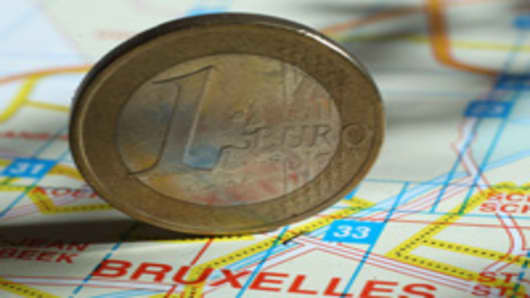The concept of Eurobonds as one tool to tackle the euro zone debt crisis has re-emerged onto the agenda this week. But how would they work and how could they help to solve the crisis?
First of all, any Eurobond, or e-bond, wouldn’t be the same as the existing eurobonds-with-a-small-e (note the potential for confusion). The latter are bonds which are issued in a different currency from the country in which they are issued (not necessarily in euros, either), and are often used by developing economies such as Nigeria and Ukraine to attract foreign investors.
A joint bond issued by euro zone countries, the Eurobond, could help some of its weaker members, as investors might be more willing to buy bonds from the entire region rather than, say, Italy or Spain. The bond market has been one of the key battlegrounds of the crisis, where countries such as Ireland and Greece have fought and lost the attempt to survive without bailout loans. A joint Eurobond could be, essentially, another way of allowing weaker euro zone economies to benefit from association with stronger economies. It could also bring the region’s fiscal integration closer.
There are still key differences between EU leaders over what form Eurobonds would take—and whether they should exist at all. Germany, anxious to avoid handing its taxpayers an even greater burden for the bailouts, especially ahead of elections later this year, is digging in its heels.
France’s new president, Francois Hollande, appears to be following his predecessor Nicolas Sarkozy in supporting the idea.
Catalysts for euro zone leaders to decide in favor of Eurobonds could include either a messy Greek exit from the euro or a run on the single currency itself, according to Justin Knight, head of European rates strategy at UBS.
There seem to be two main ideas for how the Eurobonds would start: One is to integrate the current stock of debt and issue common debt. The second, which could be more palatable for the Germans, would involve a debt redemption fund and some sharing of fiscal policy.
“Last year, the German government moved away from muddling through to the realization that the euro zone has got to move towards some form of fiscal union or face a full break up. But the possibility of moral hazard would have to be eliminated first,” Knight said.
The idea can be traced back to the Blue Bond proposal put forward by economists Jakob von Weizsäcker and Jacques Delpla in 2010. It suggests that EU countries should pool their debt up to 60 percent of GDP, which would become its senior debt. Any debt beyond this should stay as national debt for individual countries, with procedures for an orderly default in place.
One of the solutions which was put forward when talk of Eurobonds first emerged last summer came from Knight. His idea, which took the Blue Bond proposal as its starting point, suggests that governments should issue debt only in the form of eurobonds, until their Eurobond debt reaches 60 percent of GDP. Beyond that, they issue debt individually, so that the joint bond is safeguarded.
Knight said that he has not altered his view of how this model for Eurobonds could work since August. He added that the risk of subordination of a country’s non-Eurobond debt could be avoided by having countries which default on their individual debts defaulting equally on their Eurobond debt.
An independent agent to issue the new bonds would be key to their success, Knight believes.
“What’s needed is a fiscal authority to work alongside the monetary authority of the European Central Bank , which has to remain independent,” he said. “This fiscal authority would probably have to be independent of the member states, with an elected official at the top of it. Fiscal policy making needs democratic legitimacy.”



